
The Hokuriku Main Line is a 176.6-kilometer (109.7 mi) railway line owned by the West Japan Railway Company connecting Maibara Station in Maibara, Shiga, with Naoetsu Station in Joetsu, Niigata. The section between Kanazawa Station and Naoetsu Station is now operated by third-sector railways. It serves the Hokuriku region on the northern central coast of Honshu, the largest island of Japan, as well as offering connections to the regions of Kansai, Tōkai, Kantō, and Tōhoku.

Naoetsu Station is a railway station in the city of Jōetsu, Niigata, Japan, jointly operated by East Japan Railway Company and the third-sector railway operator Echigo Tokimeki Railway.

The Isumi Line is a railway line in Chiba Prefecture, Japan, operated by the third-sector railway operating company Isumi Railway Company. It extends through the central eastern section of the Bōsō Peninsula, linking Ōhara Station in the city of Isumi, where it connects with the Sotobō Line, to Kazusa-Nakano Station in the town of Ōtaki, where it connects with the Kominato Line.

The KiHa E120 (キハE120形) is a single-car diesel multiple unit (DMU) train type operated by East Japan Railway Company since November 2008.

The KiHa E130 series (キハE130系) is a class of diesel multiple unit (DMU) trains operated since January 2007 by the East Japan Railway Company in Japan.

Ichiburi Station is a railway station in Itoigawa, Niigata, Japan, operated by the third-sector railway operating companies Ainokaze Toyama Railway and Echigo Tokimeki Railway (ETR).

Tsutsuishi Station is a railway station in Itoigawa, Niigata, Japan, operated by Echigo Tokimeki Railway.
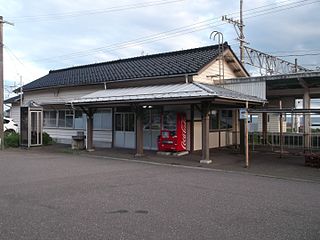
Tanihama Station is a railway station on the Echigo Tokimeki Railway Nihonkai Hisui Line in the city of Jōetsu, Niigata, Japan, operated by the third-sector railway operator Echigo Tokimeki Railway.

The KiHa 122 series and KiHa 127 series are diesel multiple unit (DMU) train types operated by West Japan Railway Company (JR-West) on the Kishin Line between Himeji and Kōzuki. A total of 19 cars have been delivered, formed as seven single-car KiHa 122 series units and six two-car KiHa 127 series units. Test-running commenced in late September 2008, with the units entering revenue-earning service from the start of the revised timetable on 14 March 2009.
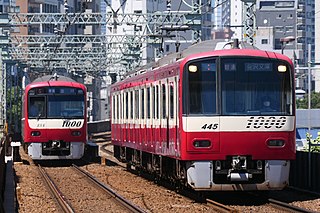
The Keikyu N1000 series is a DC electric multiple unit (EMU) train type operated by the private railway operator Keikyu on commuter services in the Tokyo area of Japan since 2002.
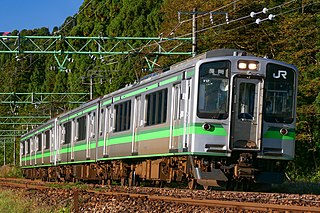
The E127 series (E127系) is a DC electric multiple unit (EMU) train type operated on local services by East Japan Railway Company in Japan since 1995, and also by the third-sector railway operator Echigo Tokimeki Railway since March 2015 as the ET127 series. The design is derived from the 209 series commuter EMU.

The KiHa 189 series is a diesel multiple unit (DMU) train type operated by West Japan Railway Company (JR-West) on Hamakaze limited express services between Osaka and Tottori since November 2010 and Biwako Express services between Osaka and Maibara since March 2014.

The 521 series is a dual-voltage AC/DC outer-suburban electric multiple unit (EMU) train type operated by West Japan Railway Company and third-sector railway operators IR Ishikawa Railway and Ainokaze Toyama Railway on local services in the Fukui and Kanazawa areas since November 2006.

The KiHa 11 (キハ11形) is a single-car diesel multiple unit (DMU) train type operated by Central Japan Railway Company and Tokai Transport Service Company (TKJ) on driver-only operated rural services in central Japan. A total of 43 cars were built between 1989 and 1999, with the class divided into four sub-classes: KiHa 11-0, KiHa 11-100, KiHa 11-200, and KiHa 11-300.

The KiHa 160 (キハ160形) was a single-car diesel multiple unit (DMU) train operated by Hokkaido Railway Company on the Hidaka Main Line in Japan. A single car was built in 1997 by Niigata Tekko to replace the KiHa 130 DMU car withdrawn due to collision damage sustained in a level crossing accident in January 1996. From 2007, the unit was rebuilt as an experimental hybrid car, branded "Inno Tech Train", before being finally withdrawn in fiscal 2013.

The Hakone Tozan 3000 series (箱根登山鉄道3000形) is a single-car electric multiple unit (EMU) train type operated by the Japanese private railway operator Hakone Tozan Railway on its steeply graded Hakone Tozan Line since 1 November 2014.
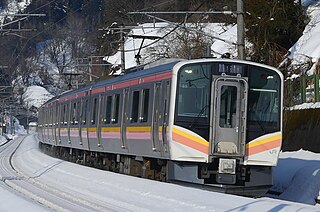
The E129 series (E129系) is a DC electric multiple unit (EMU) train type operated by East Japan Railway Company on local services in the Niigata area since 6 December 2014.
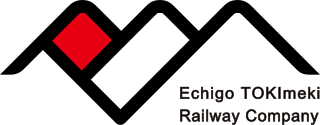
The Echigo TOKImeki Railway Company (ETR) is a Japanese third-sector railway operating company established in 2010 to operate passenger railway services on the sections of the JR East Shinetsu Main Line and JR West Hokuriku Main Line within Niigata Prefecture when they were separated from the respective JR Group operators in March 2015, coinciding with the opening of the Hokuriku Shinkansen extension from Nagano to Kanazawa. The main shareholders of the company are Niigata Prefecture, the city of Joetsu, the city of Itoigawa, and the city of Myoko.

The Ainokaze Toyama Railway is a Japanese third-sector railway operating company established in 2012 to operate passenger railway services on the section of the JR West Hokuriku Main Line within Toyama Prefecture when it was separated from the JR West network in March 2015, coinciding with the opening of the Hokuriku Shinkansen extension from Nagano to Kanazawa. The company was founded on 24 July 2012, and has its headquarters in Toyama in Toyama Prefecture.

The IR Ishikawa Railway is a Japanese third-sector railway company established in 2012 to operate passenger railway services on the section of the JR West Hokuriku Main Line within Ishikawa Prefecture. The main line was separated from the JR West network on 14 March 2015, coinciding with the opening of the Hokuriku Shinkansen extension from Nagano to Kanazawa. The company was founded on 28 August 2012 and has its headquarters in Kanazawa, Ishikawa.
























